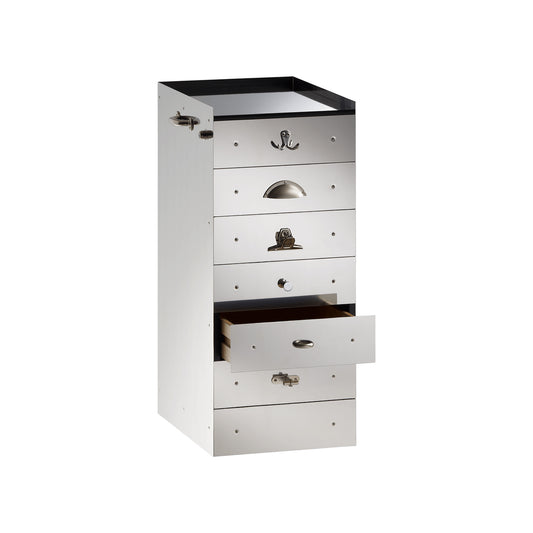Tecta is a German company specializing in the production of designer furniture and the reproduction of original Bauhaus models. Founded in 1956 from an idea by architect Hans Könecke, it is now run by the fourth generation of the family, and is distinguished by its original approach, based on the téchne of the ancient Greeks. Accordingly, Tecta has set its production from the very beginning on the unity of design, beauty and the act of creation. The company claims a role beyond that of manufacturer tout court, as evidenced by its studies of the pioneers of modernism, its relationships with designers of the caliber of Jean Prouvé, Mies van der Rohe, Walter Gropius, and the British architects Alison and Peter Smithson, who were commissioned in the 1980s to design the Kragstuhlmuseum, dedicated to the cantilever chair, better known as the cantilever chair. The company, along with the museum, is embedded in a park, dotted with sculptures, called "Tecta Landscape." Today the Tecta catalog offers, in addition to reproductions of historical pieces, chairs, armchairs, tables and furniture accessories designed by some of the most reputable designers on the contemporary scene.
The Bauhaus and BauhausNowhouse collections by Tecta
Tecta's catalog boasts a remarkable collection of faithful reissues of furniture, authorized by the Bauhaus Archive in Berlin. Prominent is the selection of cantilever chairs, such as the D40, with and without arms, designed in 1928 by Marcel Breuer, or the D42 and B42 signed by Mies van der Rohe in 1927. The elegant and unmistakable S-shaped silhouette in chrome-plated tubular steel is combined with seats and backs in wicker, leather or fabric. Walter Gropius' signature characterizes the D51 armchair and the D51-2 and D51-3 benches, with solid ash frame and fabric-covered upholstery. Also designed by Gropius, the sofas and armchairs in the F51 series take us back to the famous architect's early days, still imbued with the influence of Art Deco. Tecta also has in its catalog pieces designed by Peter Keler, the Bauhaus designer who collaborated with the company in the 1970s, starting with the iconic cradle inspired by the theories of Wassily Kandinsky, and the upholstered cube-shaped seats of the D1 series. The collection also includes small, never-before-seen gems, such as the L25 table lamp, designed in 1925 by Gerrit Thomas Rietveld, available in a limited series of 200 numbered and signed pieces.
The BauhausNowhouse collection was launched to mark the centenary of the founding of the Bauhaus in 2019. The collection consists of a series of iconic furnishings reinterpreted according to the personal language of the young designers who participated in the experience. Each piece acquires a contemporary look while keeping the basic concepts of the project intact. Thus was born the D4N Edition EW, a poetic version of Breuer's D4 by designer Esther Wilson, who embroidered delicate blocks of color on the seat and back fabric. Or the sublime transformation of Gropius's F51N armchair by Katrin Greiling into a brightly colored sculpture in which the rigorous geometry of the frame dialogues with the soft fabrics designed by Belgian designer Raf Simons for Kvadrat.
Beyond Bauhaus, Tecta solutions that defy time
Tecta collections designed from scratch are always inspired by Bauhaus concepts, or are designed by the masters themselves in exclusive collaboration with the company. The intent is to create objects capable of defying time, in terms of the life cycle of materials and aesthetic and functional value. Thus chairs such as Daniel Lorch's Split Chair, which reinterprets the classic tubular steel model, or Wolfgang Hartauer's D9 cantilever chair, a highly successful homage to Breuer's genius, take shape. And it is precisely the cantilever chairs that represent the most substantial part of the catalog, from the D43 created in the 1960s for Tecta by William Dunkel, to Stefan Wewerka's surprising B5, now dating from 1982, a small jewel of lightness and fluidity. Not to be overlooked is the range of tables and coffee tables, such as those in the Oblique collection, developed by Tecta in 2005. The frame consists of a single piece of flattened tubular steel, made by a patented process, which restores an elegant and original aesthetic to the furniture. The collection includes coffee tables, desks, side tables and nightstands, with lacquered wood tops declined in different colors. For lovers of important and massive forms, the M21 table, in wood veneer, is derived from a design by Jean Prouvé, and features characteristic circular holes in the base. Among the accessories, the Tecta Cat ornament, designed by Dominik Kirgus, stands out; it is inspired by the geometric shapes typical of Bauhaus and has now become a recognizable symbol of the company.






















